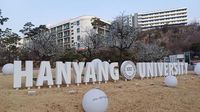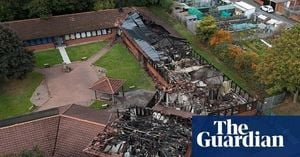A fire broke out in a laboratory at Hanyang University in Seoul on the evening of April 8, 2025, following an explosion linked to the handling of hydrofluoric acid. The incident, which occurred at approximately 9:01 PM in the Shinsojae Engineering Building, resulted in injuries to four students, with one suffering severe facial burns.
According to the Seongdong Fire Station, the explosion happened while students were in the process of disposing of hydrofluoric acid. The force of the blast caused significant concern, prompting an emergency response that involved the evacuation of about 50 individuals from the building.
Reports indicate that one student was critically injured and transported to a nearby hospital for urgent care. Additionally, another student sustained injuries and was also taken to the hospital, while two others received treatment for minor injuries. Fortunately, the fire department confirmed that the hydrofluoric acid did not leak outside the laboratory during the incident.
Firefighters quickly mobilized to the scene, deploying 39 personnel and 11 vehicles to manage the situation. Their efforts were focused on extinguishing the flames and ensuring that all hazardous materials were safely removed. By 9:54 PM, just under an hour after the explosion, the fire was completely under control, and the removal operations for the hydrofluoric acid were underway.
As the investigation continues, authorities are working to determine the precise cause of the explosion. Initial assessments suggest that the accident occurred during routine laboratory procedures, raising questions about safety protocols in place for handling such dangerous substances.
This incident highlights the inherent risks associated with laboratory work, particularly in environments where hazardous materials are present. Educational institutions like Hanyang University are expected to maintain rigorous safety standards to protect students and staff from potential accidents.
In the wake of the explosion, university officials have expressed their concern for the injured students and their families, pledging to cooperate fully with the ongoing investigation. They are also reviewing safety measures to prevent similar incidents in the future.
While the immediate danger has been addressed, the broader implications of this incident may lead to increased scrutiny of laboratory safety practices not only at Hanyang University but across educational institutions that engage in chemical research.
As the investigation unfolds, the university community and the public are left to ponder the critical importance of safety in scientific exploration. The hope is that lessons learned from this incident will lead to improved safety protocols that can safeguard students and staff alike.





